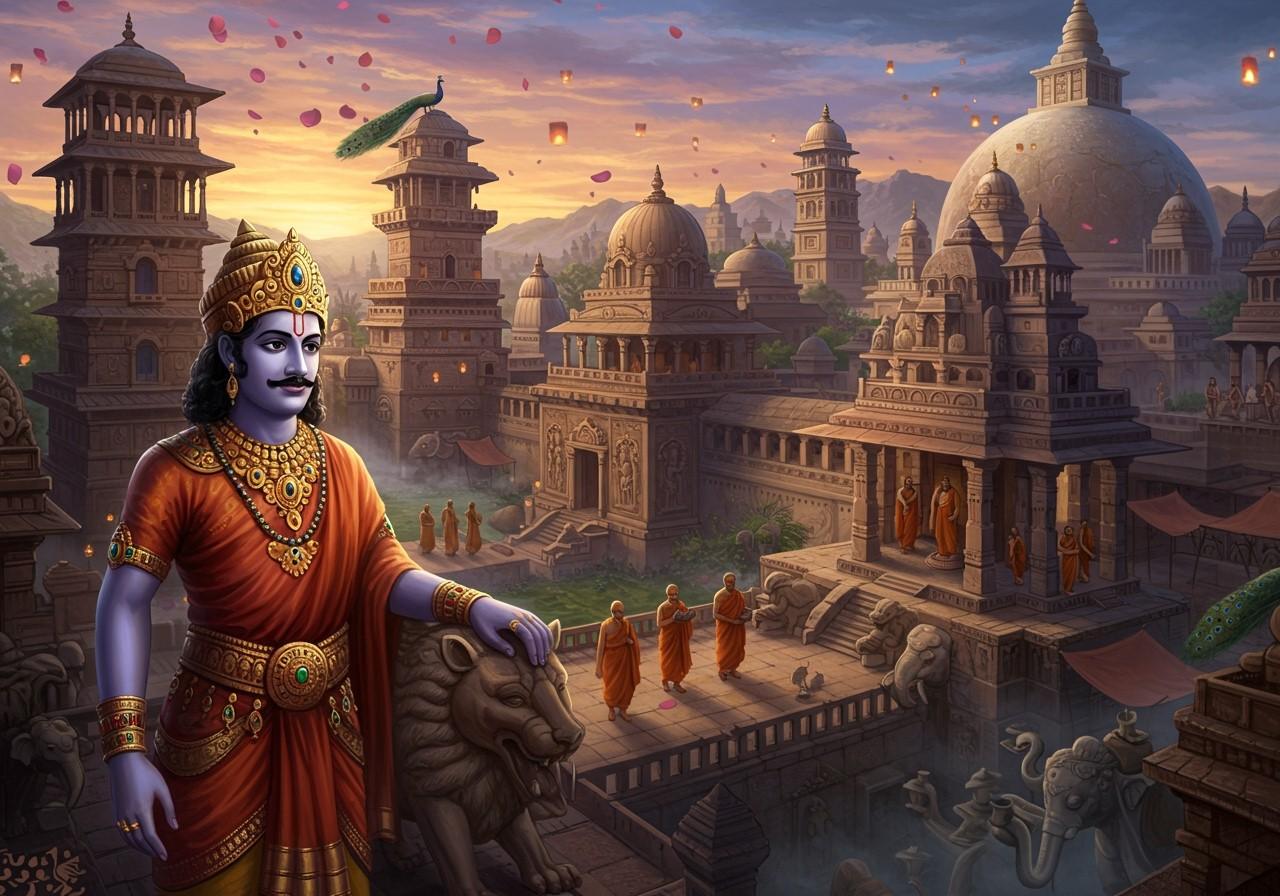
Pataliputra, the ancient capital of the Mauryan Empire, holds a prominent place in Indian history. Under Emperor Ashoka’s rule (circa 268 to 232 BCE), the city flourished as a center of political power, economic prosperity, and cultural significance. Ashoka’s reign marked a pivotal moment for Buddhism, profoundly influencing India’s religious landscape. Understanding Pataliputra’s role during this era offers invaluable insights into India’s rich heritage.
Pataliputra: The Mauryan Capital
Strategically situated at the confluence of the Ganges, Son, and Gandak rivers, Pataliputra commanded a prime location that made it a bustling hub of commerce and trade. The city’s architecture showcased its grandeur, with impressive fortifications, palaces, and public buildings. Ashoka, departing from tradition, transitioned from wood to stone as the primary construction material, erecting a magnificent palace entirely of stone, a testament to the city’s opulence and his innovative spirit.
Pataliputra served as a vibrant political and economic nerve center, boasting efficient administration and advanced urban planning. It attracted scholars, traders, and artisans from all corners of the empire, fostering a cosmopolitan atmosphere. As a prominent center for Buddhist teachings, Pataliputra played a crucial role in the dissemination of Buddhism throughout the region.
Ashoka’s Transformation and Embrace of Buddhism
Ashoka’s early reign was characterized by military conquests, notably the brutal Kalinga War. However, the war’s devastating aftermath deeply impacted Ashoka, leading to his profound remorse and subsequent conversion to Buddhism. Embracing Buddhist principles of non-violence, compassion, and tolerance, Ashoka initiated a transformative shift in his governance and policies.
Ashoka’s edicts, inscribed on pillars and rocks throughout his empire, actively promoted Buddhist principles. He generously supported the construction of stupas and viharas, providing vital support for Buddhist monastic communities and missionary activities. This royal patronage significantly impacted his reign and facilitated the widespread propagation of Buddhism.
The Third Buddhist Council: A Landmark Event
To address doctrinal disputes and ensure the purity of the Buddhist Sangha, Ashoka convened the Third Buddhist Council in Pataliputra around 250 BCE. Presided over by the esteemed monk Moggaliputta Tissa, the council meticulously compiled the Kathavatthu, a crucial text addressing doctrinal controversies, and reaffirmed the Theravada tradition, a significant school of Buddhist thought.
The council played a pivotal role in organizing and dispatching Buddhist missionaries to various regions, including Sri Lanka and Central Asia. By standardizing Buddhist teachings and practices, the Third Buddhist Council solidified Buddhism’s position as a major world religion.
Ashoka’s Legacy and the Spread of Buddhism
Ashoka’s reign had a far-reaching impact on Buddhism’s expansion beyond India’s borders. His missionary initiatives led to the establishment of thriving Buddhist centers in Sri Lanka, Southeast Asia, and Central Asia. Ashoka’s inscriptions and pillars served as enduring testaments to Buddhist teachings, preserving them for generations to come.
Subsequent Indian rulers and dynasties drew inspiration from Ashoka’s policies, and his legacy of righteous kingship continues to be revered within Buddhist traditions.
Pataliputra Today: A Glimpse into the Past
Today, exploring the archaeological remnants of ancient Pataliputra offers a captivating journey into the past. The ruins of the city, including remnants of its magnificent palaces, provide tangible evidence of its former glory. Key archaeological sites such as Kumhrar, Agam Kuan, and Bulandi Bagh offer invaluable insights into Pataliputra’s historical significance.
Ongoing efforts to preserve and study these archaeological treasures underscore Pataliputra’s enduring legacy. Museums and institutions house artifacts unearthed from these sites, shedding light on the city’s rich and vibrant history. Pataliputra continues to captivate scholars and tourists alike, drawing them to explore the fascinating world of ancient Indian history and Buddhism.
Poojn.in: Your Source for Authentic Ritual Items
Deepen your connection with the rich spiritual traditions of India with authentic ritual items from Poojn.in. As India’s leading provider of cultural goods and services, we offer a wide selection of high-quality products to enhance your spiritual practices.
- Ashoka Chal Powder: Incorporate this sacred powder into your Tuesday rituals for Lord Hanuman, following ancient traditions. Available in various sizes to suit your needs.
- Pooja Asan: Enhance your meditation practice with a comfortable and beautifully crafted asan. Choose from a variety of colors and sizes.
- Marble Dust Murtis: Bring divine presence into your home with intricately crafted murtis of revered deities like Sai Baba and Lord Shiva.
- Mangalam Camphor: Create a sacred atmosphere during your rituals and ceremonies with pure camphor. Available in convenient butter paper and tablet forms.
Explore the complete collection at poojn.in and discover a wide range of products to support your spiritual journey.
FAQs: Pataliputra and Ashoka: Buddhism’s Rise in an Empire
What is Pataliputra? Pataliputra, present-day Patna, served as the capital of the Mauryan Empire. Its strategic location at the confluence of major rivers made it a hub of trade and culture.
Who was Ashoka? Ashoka, the third Mauryan emperor (circa 268-232 BCE), initially known for his military prowess, later embraced Buddhism and became a champion of peace and non-violence.
How did Ashoka’s transformation impact Pataliputra? Ashoka’s conversion to Buddhism significantly influenced Pataliputra’s cultural landscape. The city became a center for Buddhist learning and missionary activities, with numerous stupas and viharas erected under his patronage.
What was the significance of the Third Buddhist Council? Convened by Ashoka in Pataliputra around 250 BCE, the Third Buddhist Council played a crucial role in resolving doctrinal disputes, standardizing Buddhist teachings, and organizing missionary efforts that spread Buddhism across Asia.


